 The rouble’s been Russia’s currency for the past 500 years. One rouble is divided into 100 kopecks. The word first appeared in the 13th century, thought to have come from the Russian verb “rubit” (“to chop”) as “rouble” used to be half a standard silver bar. When first silver coins were minted in the 15th century, the rouble became the official currency unit. The kopecks (“kopeyka”) got their name from the Russian “kopye” (“spear”) because they featured an image of St. George slaying a dragon with a spear.
The rouble’s been Russia’s currency for the past 500 years. One rouble is divided into 100 kopecks. The word first appeared in the 13th century, thought to have come from the Russian verb “rubit” (“to chop”) as “rouble” used to be half a standard silver bar. When first silver coins were minted in the 15th century, the rouble became the official currency unit. The kopecks (“kopeyka”) got their name from the Russian “kopye” (“spear”) because they featured an image of St. George slaying a dragon with a spear.
In Tsarist Russia, rouble coins were mostly silver but were also minted in gold or platinum. The first USSR banknotes appeared in 1924, featuring the Soviet state emblem with 6 bands around ears of wheat. They represented the languages of the 4 original members of the Soviet Union – the Russian, Transcaucasian (which included Azerbaijan, Armenia and Georgia), Ukrainian and Belorussian Republics. Later, most Soviet banknotes carried the portrait of Lenin.
During the Gorbachev reforms and the tumult of the 1990s, the rouble lost much of its value, prompting Russians to refer to it bitterly as the “wooden rouble”. After the fall of the USSR, the U.S. dollar became widespread throughout Russia, and was used as the unofficial currency for cash savings and paying large sums of money. As Russia’s economy recovered, so did the rouble’s reputation. In 2004 a five-meter tall monument to the rouble was erected in the city of Dimitrovgrad, in the south-west of Russia. Modern Russian banknotes are notable for their lack of portraits, instead showing Russia’s landmarks.
Currently seven denominations of banknotes are valid: 5, 10, 50, 100, 500, 1000 and 5000 roubles. Coins exist for both kopecks (1, 5, 10, 50) and roubles (1, 2, 5, 10). Apart from standard coins, there are also the so-called jubilee coins to mark special occasions.
You can exchange currency at airports, banks and at exchange bureaux dotted across most cities, indicated by the word “exchange” or in Russian «обмен валют» (“obmyen valyut”, commonly known as “obmennik”) with exchange rates displayed.ATMs are found virtually everywhere in cities, so getting cash is usually not a problem. The Russian for ATM is “bankomat” – a compound word for “banking automaton”. Many stores and restaurants across Russia only accept cash – make sure you find out if they take credit or debit cards before you buy or order anything.
Here’s what Russian banknotes look like.
5 Roubles
This banknote is almost out of use, being replaced by a 5 rouble coin. The green note shows the Millennium of Russia – a 19th century monument in the city of Novgorod, marking a 1000 years of Russia’s history. Behind it is Novgorod’s St. Sophia Cathedral. The reverse displays the Novgorod Kremlin (although “Kremlin” commonly refers to the Moscow Kremlin, it’s an old word for “fortress” and many historic Russian cities have one).
10 Roubles
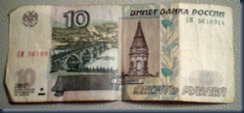 The dark-green and brown note carries an image of a bridge across Yenisey River in Krasnoyarsk – a major Siberian city. Coming from Mongolia and flowing to the Arctic Ocean, Yenisey is the world’s fifth-longest river.
The dark-green and brown note carries an image of a bridge across Yenisey River in Krasnoyarsk – a major Siberian city. Coming from Mongolia and flowing to the Arctic Ocean, Yenisey is the world’s fifth-longest river.
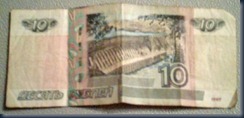 The reverse shows the Krasnoyarsk hydropower dam – the city’s major landmark.
The reverse shows the Krasnoyarsk hydropower dam – the city’s major landmark.
50 Roubles
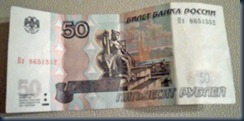 The blue and violet note displays a sculpture at the foot of one of two Rostral Columns in St. Petersberg. Flanking the former Stock Exchange Building, the columns served as oil-fired navigation beacons in the 1800s (on some public holidays, gas torches are still lit on them). In the background is the famous Petropavlovsk fortress. Established by Peter the Great, it became a jail for high-ranking political prisoners. The fortress is now a museum.
The blue and violet note displays a sculpture at the foot of one of two Rostral Columns in St. Petersberg. Flanking the former Stock Exchange Building, the columns served as oil-fired navigation beacons in the 1800s (on some public holidays, gas torches are still lit on them). In the background is the famous Petropavlovsk fortress. Established by Peter the Great, it became a jail for high-ranking political prisoners. The fortress is now a museum.
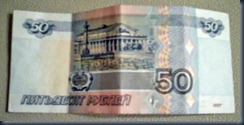 The reverse has the former Stock Exchange Building that now houses the city’s Central Naval Museum.
The reverse has the former Stock Exchange Building that now houses the city’s Central Naval Museum.
100 Roubles
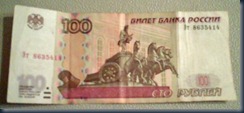 The brown and red banknote shows a sculpture on the portico of Moscow’s legendary Bolshoi Theatre and a horse-drawn chariot of Apollo (the god of the arts in Greek mythology).
The brown and red banknote shows a sculpture on the portico of Moscow’s legendary Bolshoi Theatre and a horse-drawn chariot of Apollo (the god of the arts in Greek mythology).
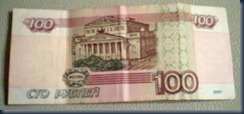 The reverse displays the entire building, one of the world’s largest theatres.
The reverse displays the entire building, one of the world’s largest theatres.
500 Roubles
The violet and blue banknote displays a monument to Peter the Great, a sailing ship and sea terminal in Arkhangelsk, in Russia’s north. It was Peter who, in 1693, ordered the creation of a state shipyard there. The reverse shows the Solovetsky Monastery. Founded in the 15th century it used to be a major spiritual centre and pilgrimage destination. During Soviet times the monastery served as a Soviet prison camp. Today, it’s a World Heritage Site, museum and home to a handful of monks.
1000 Roubles
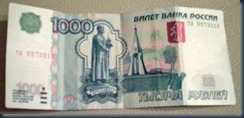 The blue-green note shows a monument to Yaroslav the Wise – the founder of the city of Yaroslavl, 250 km from Moscow. His long reign turned Russia into a cultural and military power in the 11th century. Behind, is a chapel of the city’s Kremlin,
The blue-green note shows a monument to Yaroslav the Wise – the founder of the city of Yaroslavl, 250 km from Moscow. His long reign turned Russia into a cultural and military power in the 11th century. Behind, is a chapel of the city’s Kremlin,
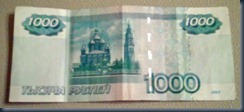 while the reverse displays Yaroslavl’s Church of St. John the Precursor.
while the reverse displays Yaroslavl’s Church of St. John the Precursor.
5000 Roubles
The red-orange note displays a monument to Nikilay Muravyov-Amursky, a 19th century Russian statesman and diplomat, who played a major role in the expansion of the Russian Empire towards the Pacific Rim. The monument is in Khabarovsk – a major city in the Russian Far East. On the reverse is the Khabarovsk Bridge, taking the Trans-Siberian Railway across the Amur River.





No comments:
Post a Comment